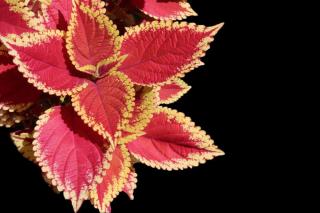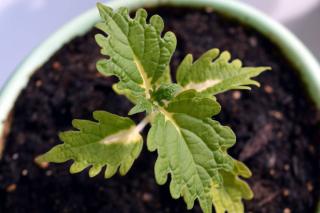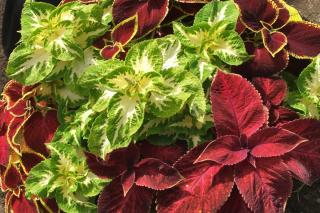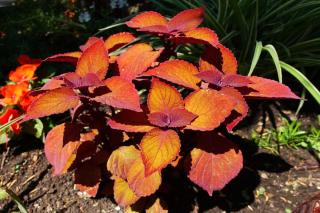

Coleus is a magnificent tropical plant, noted for the beauty of its colorful, mottled foliage.
Summary of Coleus facts
Name – Coleus
Family – Labiaceae
Type – perennial, indoor plant
Exposure – shaded
Soil: ordinary & well drained soil mix – Foliage: evergreen – Flowering: summer → early fall
It can be grown in the garden during summertime, and also indoors over winter: it adapts perfectly.
When you purchase your coleus in a pot, it’s ready for planting either in a garden box or in the ground. It loves fertile and moist soil.
Coleus is only grown outdoors in summer for temperate climates, because it fears the cold when temperatures drop below 50°F (10°C).
 In a garden box, you can plant your coleus in a good soil mix.
In a garden box, you can plant your coleus in a good soil mix. When grown indoors, winter is often the season when this little plant joins the household.
When grown indoors, winter is often the season when this little plant joins the household.
It isn’t mandatory to repot your coleus immediately after purchase, unless the roots show that they’re feeling squeezed.
Coleus isn’t a very picky plant but it does need some attention, especially to protect and preserve its nice colored, spotted leaves.
Adding fertilizer isn’t a requirement, but it may be an option if you notice that the leaves start turning pale or white. This shows that the soil has become too poor.
The colored leaves are the reason for growing the coleus plant, it ranges from red to pink, from green to white and from yellow to brown.
To ensure that this magnificent coloration stays true, the coleus plant requires sunlight, while avoiding situations that would scorch it.
 Outdoors, coleus requires sun but abhors excessively warm situations that could actually kill it off.
Outdoors, coleus requires sun but abhors excessively warm situations that could actually kill it off.
Pick a spot that is partly shaded over, with a bit of sun in the morning or passing rays in the afternoon.
In winter, it’s great to give it as much light and sun as you can for most of the day, to ensure it grows and develops and try to keep all the leaves attached.
In summer, however, refrain from placing your coleus near a window facing south, because the sunlight would burn the plant.
Coleus is certainly one of the most beautiful leaf plants to grow at home. With such bright colors, this amazingly easy plant to care for is ideal for pots or garden boxes.
It actually fits right in on any terrace or balcony in summer or indoors in winter. But feel free to also include a few specimens in the middle of your flower beds, you’ll notice that it interestingly catches the eye.
Although its leaves are very similar to those of stinging nettles, there’s nothing to worry about because it is neither invasive nor urticant.
 Coleus is vulnerable to mealy bugs and it’s often difficult to get rid of them if not caught early. Whitish masses colonize leaves.
Coleus is vulnerable to mealy bugs and it’s often difficult to get rid of them if not caught early. Whitish masses colonize leaves.
There are also other parasites like a couple famous bugs, the red spider mite indoors and aphids in summer. Snails and slugs show signs of interest in moist weather.
Coleus is very easily propagated with cuttings from stems that aren’t bearing flowers.
Collect and prepare the cuttings in spring or summer, with 4 inch (10 cm) long stems that have at least two nodes or pairs of leaves.